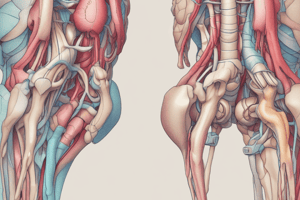Podcast
Questions and Answers
Which type of primary cartilaginous joint allows for bone growth in length?
Which type of primary cartilaginous joint allows for bone growth in length?
- Symphysis joint
- Primary synovial joint
- Synovial joint
- Secondary cartilaginous joint (correct)
What type of joint joins bones by cartilage or a combination of cartilage and fibrous tissue?
What type of joint joins bones by cartilage or a combination of cartilage and fibrous tissue?
- Primary synovial joint
- Secondary synovial joint
- Secondary cartilaginous joint (correct)
- Primary cartilaginous joint
Where can secondary cartilaginous joints be primarily found in the body?
Where can secondary cartilaginous joints be primarily found in the body?
- In the facial bones
- Along the midline of the body (correct)
- Along the limbs
- In the hands and feet
What happens to the epiphysial plate in a primary cartilaginous synchondrosis joint when full growth is achieved?
What happens to the epiphysial plate in a primary cartilaginous synchondrosis joint when full growth is achieved?
Which type of cartilaginous joint is characterized by having an intervening fibrocartilaginous disc?
Which type of cartilaginous joint is characterized by having an intervening fibrocartilaginous disc?
Flashcards
Cartilaginous joint type for growth
Cartilaginous joint type for growth
A primary cartilaginous joint, specifically a synchondrosis, allows bones to grow in length.
Secondary cartilaginous joints connect?
Secondary cartilaginous joints connect?
Bones through cartilage or a mix of cartilage and fibrous tissue.
Secondary cartilaginous locations?
Secondary cartilaginous locations?
Primarily found along the body's midline.
Epiphyseal plate's fate in growth?
Epiphyseal plate's fate in growth?
Signup and view all the flashcards
Fibrocartilaginous joint type?
Fibrocartilaginous joint type?
Signup and view all the flashcards
Study Notes
Cartilaginous Joints (Amphiarthrosis)
- Bones are joined by cartilage, or by cartilage and fibrous tissue.
Primary Cartilaginous Joints (Synchondrosis)
- The bony ends (articular surfaces) are fused by hyaline cartilage.
- Examples include the epiphysial plate of the growing long bones connecting the diaphysis with the epiphysis.
- Primary cartilaginous joints permit growth in the length of a bone.
- When full growth is achieved, the epiphysial plate converts to bone and the epiphyses fuse with the diaphysis.
Secondary Cartilaginous Joints (Symphysis)
- The articular surfaces are lined by hyaline cartilage with an intervening fibrocartilaginous disc.
- Joints of this type are strong, slightly movable, and united by fibrocartilage.
- They are located along the midline of the body.
- Examples of this type include the intervertebral joints between the vertebral bodies, the manubriosternal joint, and the symphysis pubis.
Studying That Suits You
Use AI to generate personalized quizzes and flashcards to suit your learning preferences.
Description
Explore the characteristics of cartilaginous joints, focusing on primary cartilaginous joints like synchondrosis. Learn about how these joints permit bone growth and the process of fusion when full growth is achieved.




